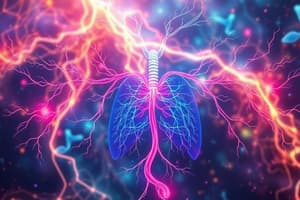Podcast
Questions and Answers
What are the two main control systems of the body that maintain homeostasis?
What are the two main control systems of the body that maintain homeostasis?
- Circulatory and Endocrine
- Endocrine and Exocrine
- Muscular and Nervous
- Nervous and Endocrine (correct)
Endocrine glands use ducts to release hormones.
Endocrine glands use ducts to release hormones.
False (B)
What type of cells make up endocrine glands?
What type of cells make up endocrine glands?
Epithelial cells
Which hormone is released by the parafollicular cells of the thyroid gland?
Which hormone is released by the parafollicular cells of the thyroid gland?
Where is the thyroid gland located?
Where is the thyroid gland located?
The _____ cells of the pancreas release glucagon.
The _____ cells of the pancreas release glucagon.
What hormone does the beta cells of the pancreas release?
What hormone does the beta cells of the pancreas release?
What is the main function of T3 and T4 hormones?
What is the main function of T3 and T4 hormones?
Match the following glands with their characteristics:
Match the following glands with their characteristics:
The anterior pituitary is primarily composed of neural tissue.
The anterior pituitary is primarily composed of neural tissue.
Flashcards are hidden until you start studying
Study Notes
Endocrine System Overview
- The body has two primary control systems for homeostasis: endocrine and nervous.
- The endocrine system regulates metabolic activity via hormones, which are chemical messengers that travel through the blood to specific target cells.
- Hormones can be categorized into amino acid-based or steroid-based types.
- Endocrine components, including cells, tissues, and organs, are dispersed throughout the body and typically operate more slowly with prolonged effects.
General Characteristics of Endocrine System
- Endocrine glands are primarily composed of epithelial cells and have a cuboidal shape.
- These glands are ductless, releasing hormones directly into extracellular fluid (ECF) or bloodstream.
General Anatomy of Endocrine System
- Endocrine tissue can take various forms:
- Whole glands (e.g., parathyroid and thyroid)
- Partial glands (e.g., anterior and posterior pituitary)
- Partial organs (e.g., islets of the pancreas)
- Patches of tissue within organs (e.g., gastrin-releasing cells in the stomach)
- Neuroendocrine tissues (e.g., hypothalamus, adrenal medulla)
- Malignant tissue (e.g., lung cancer)
Thyroid Gland
- Shaped like a butterfly, located in the anterior neck, on the trachea below the larynx.
- Responsible for releasing thyroid hormones (T3 and T4) which regulate metabolism.
- Thyroid can be palpated when swallowing due to its movement.
Thyroid Gland Histology
- Consists of follicles, which are hollow and may contain colloid (protein).
- Follicular cells form the follicle walls; they are typically cuboidal or squamous in shape.
- Parafollicular cells, located between the follicles, produce calcitonin which lowers blood calcium levels.
Thyroid Gland Hormones
- Follicles release stored thyroid hormones by utilizing colloids.
- T3 (active form) and T4 (thyroxin) synthesized by follicular cells increase metabolic rate and cellular oxidation.
- Parafollicular cells secrete calcitonin for calcium regulation.
Parathyroid Glands
- Composed of four bean-shaped glands, located on the posterior aspect of the thyroid.
- The number of parathyroid glands can vary across individuals.
Parathyroid Histology
- Contains chief cells, which stain blue-purple and release parathyroid hormone (PTH) to elevate blood calcium levels.
- Larger oxyphil cells are lighter in color, with an unknown function.
Pancreas
- Functions in chemical digestion and is located partially behind the stomach.
- Comprises both endocrine (islets of Langerhans) and exocrine glands (acinar cells).
Pancreas Histology
- Islets of Langerhans appear as round, lighter-stained clusters of endocrine cells, accounting for about 2% of pancreatic cells.
- Acinar cells are darker exocrine cells surrounding the islets.
Islets of Langerhans
- Consist of alpha cells (secrete glucagon to raise blood glucose, found at periphery), beta cells (secrete insulin to lower blood glucose, appear grey-blue), and delta cells (secrete somatostatin).
Pituitary Gland
- Known as hypophysis, located within the sphenoid bone, features two major lobes: anterior (glandular tissue) and posterior (mainly neural tissue).
Anterior Pituitary
- Also called Adenohypophysis; its activity is regulated by the hypothalamus via chemical signals.
- Produces and releases six protein hormones, four of which are tropic hormones targeting other endocrine glands to stimulate hormone secretion.
- Composed of acidophilic cells that typically stain orange/brown, producing growth hormone (GH) that targets liver, muscle, bone, and cartilage.
Studying That Suits You
Use AI to generate personalized quizzes and flashcards to suit your learning preferences.




